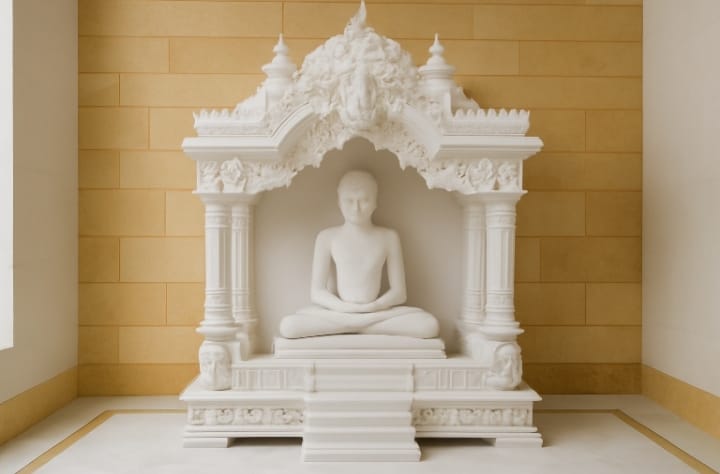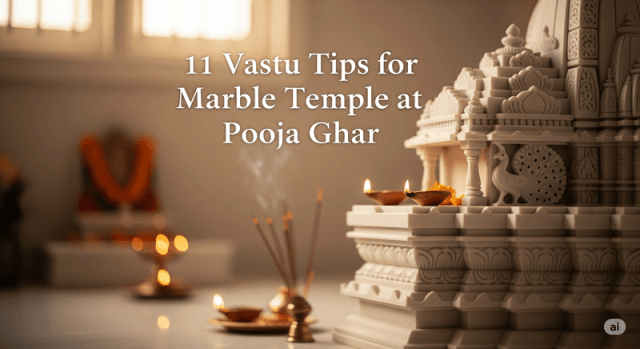Creating a Sacred Jain Pooja Ghar: A Guide to Tradition, Materials, and Vast
A Jain pooja room serves as more than just a place of worship—it is a sacred space that embodies the core principles of Jainism: purity, simplicity, and spiritual transcendence. When designing a pooja room that honors Jain traditions, careful consideration must be given to direction, materials, and the spiritual atmosphere that fosters meditation and devotion.
Understanding Jain Spiritual Values
Jainism emphasizes the concept of ahimsa (non-violence), satya (truth), and the pursuit of spiritual purity[1]. These principles profoundly influence every aspect of a Jain pooja room, from the materials selected to the daily practices performed within its sacred walls. The goal is to create a space that promotes inner purification and supports the journey toward moksha (liberation)[1].
Essential Vastu Guidelines for Jain Pooja Ghar
Direction and Placement of Jain Pooja Ghar
According to Vastu principles, the pooja room should be positioned in the northeast, north, or east direction[2][3]. This placement ensures maximum positive energy flow and aligns with traditional spiritual practices. The idols should face east or west, meaning devotees should face these directions while praying[2][3].
Height and Positioning of Idols
Jain idols should be placed at a respectful height, never directly on the floor[2]. Maintain at least one inch distance from the wall when positioning idols on their throne (singhason)[3]. The ideal height for idols is 9-10 inches, avoiding excessive size that might create imbalance in the sacred space[3].
Essential Vastu Elements
- Lighting: Use dim, soft lighting similar to traditional temples, with diyas or candles placed in the southeast or east corner[3][4]
- Colors: Opt for white, light yellow, or light blue walls, symbolizing purity, simplicity, and positive energy[4][5]
- Ceiling Design: Consider a pyramid-shaped ceiling resembling temple gopuras, which attracts positive energy[3][4]
- Ventilation: Ensure adequate ventilation with doors and windows facing east or north[5]
The Sacred Significance of White Marble
Spiritual Symbolism for Jain Pooja Ghar
White marble holds profound significance in Jain tradition, representing purity, peace, and spiritual transcendence[6]. Its pristine white appearance aligns perfectly with Jain values, creating an atmosphere conducive to meditation and prayer[6]. The smooth, lustrous surface of marble symbolizes the inner purity and enlightenment that Jain followers strive to achieve[6].
Creating Sacred Atmosphere
The cool, serene appearance of white marble is believed to create an environment that enhances meditation and spiritual contemplation[6]. This natural stone’s inherent properties support the Jain pursuit of mental clarity and spiritual advancement, making it an ideal choice for sacred spaces.
Makrana White Marble: The Premium Choice
Historical Legacy
Makrana marble, sourced from Rajasthan, has been the material of choice for Jain temples for centuries[7][8]. This premium marble is renowned for its exceptional purity, durability, and spiritual significance in Indian religious architecture.
Craftsmanship and Quality
Makrana marble temples feature:
- Handcrafted precision with traditional techniques[8]
- Premium quality stone with superior durability[8]
- Intricate carvings that showcase master craftsmanship[8]
- Customizable designs to fit specific space requirements[8]
The natural properties of Makrana marble make it particularly suitable for creating jali work (lattice patterns) that filter divine light into the pooja space, enhancing the spiritual atmosphere[8]. Jain Pooja Ghar is sacred.
Vietnam White Marble: Modern Elegance
Vietnam white marble has gained popularity for contemporary Jain pooja rooms, offering:
- Consistent white coloration that maintains purity symbolism[9][10]
- Modern finishing techniques while preserving traditional designs[10]
- Durability and longevity suitable for daily worship practices[10]
Vietnam marble temples can accommodate larger dimensions, with some reaching 10 feet in height and 7.5 feet in width, making them suitable for spacious homes[10].
Jaisalmer Yellow Sandstone: Golden Heritage
Traditional Significance
The golden-yellow sandstone from Jaisalmer holds special place in Jain architecture[11][12]. The historic Jain temples within Jaisalmer Fort, built between the 15th and 16th centuries, showcase the beauty and spiritual significance of this material[12].
Architectural Beauty
Jaisalmer sandstone temples feature:
- Elaborate carvings of Jain Tirthankaras[11]
- Intricate filigree work demonstrating master craftsmanship[11]
- Golden hue that creates a warm, divine atmosphere[11]
- Historical authenticity connecting modern worship to ancient traditions[12]
Embracing Divinity Through Simplicity
Core Jain Principles
Jain tradition emphasizes that true devotion lies in bhava (inner purity) rather than elaborate dravya (materials)[13]. The pooja room should reflect this philosophy through:
Minimalist Approach
- Clutter-free environment: Maintain clean, organized space with essential items only[3][4]
- Natural materials: Use cotton, wood, and stone for seating and accessories[3]
- Simple decorations: Focus on fresh flowers and natural fragrances rather than artificial ornaments[4]
Daily Practices
Traditional Jain pooja room practices include:
- Maintaining silence during worship[13]
- Wearing clean, preferably white clothing[13][14]
- Daily cleaning to maintain purity standards[13][5]
- Using natural materials for all worship accessories[3]
Essential Elements for Authentic Jain Pooja Rooms
Sacred Items and Arrangement
- Dank (brass or silver bowl with holes for sprinkling water)[14]
- Fresh flowers and fruits offered daily[4][14]
- Sandalwood paste for tilak and idol decoration[14]
- Incense and natural fragrances like sandalwood, jasmine, or basil[4]
- Storage solutions in south or west walls for pooja accessories[3]
Color Scheme and Aesthetics
Choose colors that promote spiritual atmosphere:
- White: Symbolizing purity and spiritual cleanliness[4][5]
- Light yellow: Representing positive energy and auspiciousness[4][5]
- Light blue: Creating calmness and serenity[4]
Avoid dark colors like brown, navy blue, or black as they may increase negative energies[4].
Maintenance and Daily Care
Spiritual Hygiene
Maintaining a Jain pooja room requires:
- Daily cleaning with natural materials[13][5]
- Regular replacement of flowers and offerings[4]
- Proper ventilation to maintain air purity[5]
- Respectful handling of all sacred items[13]
Long-term Preservation
For marble and sandstone elements:
- Regular polishing to maintain luster[7][8]
- Proper drainage to prevent water damage[5]
- Professional maintenance for intricate carvings[6]
A well-designed Jain pooja room serves as a bridge between the material and spiritual worlds, honoring centuries-old traditions while creating a space for daily devotion and meditation. By carefully selecting appropriate materials like Makrana or Vietnam white marble, or traditional Jaisalmer sandstone, and following Vastu guidelines rooted in Jain values, devotees can create a sacred space that truly embodies the principles of purity, simplicity, and spiritual transcendence that define Jainism.
YOU ARE ONE STEP AWAY FROM YOUR SACRED JAIN POOJA GHAR
GET IN TOUCH
Schedule a Visit
Citations:
[1] Jainism https://en.wikipedia.org/wiki/Jainism
[2] 6+ Pooja Room Vastu Tips for Positive Energy and Prosperity https://www.woodenstreet.com/blog/pooja-room-vastu
[3] Pooja room vastu : Vastu tips for Mandir or Temple – AppliedVastu https://www.appliedvastu.com/pooja-room-vastu
[4] Pooja room Vastu: Know the best direction for Mandir at home https://housing.com/news/vastu-shastra-tips-temple-home/
[5] Vastu tips for Pooja Room Direction for positive space – JK Cement https://www.jkcement.com/blog/vastu/vastu-tips-for-pooja-room/
[6] The Role of Marble in Jain Temples: A Historical Perspective https://www.pandeymarblearts.com/blog/the-role-of-marble-in-jain-temples-a-historical-perspective/
[7] White Marble Jain Temple Manufacturer from Makrana https://www.desiremarbles.com/jain-marble-temple.html
[8] White Marble Temple – White Marble Mandir For Home from Makrana https://www.mahnoormarbleart.com/white-marble-temple.html
[9] Exclusive Marble Temple For Pooja Room https://www.indiamart.com/faizan-marble-suppliersmakrana/exclusive-marble-temple-for-pooja-room.html
[10] Introducing Our Latest Vietnam Marble Jain Pooja Ghar … https://www.instagram.com/p/DFE673Hy5BY/
[11] Jain Temples of Jaisalmer- Architectural Marvels – Incredible India https://www.incredibleindia.gov.in/en/rajasthan/jaisalmer/jain-temples-of-jaisalmer
[12] Temples in Jaisalmer ( List of 7 Jain Temples ) – PlanYourTour https://planyourtour.in/jaisalmer/7-jain-temples-in-jaisalmer/
[13] How to do Pooja in derasar | JainGPT by Jain Knowledge https://jainknowledge.com/question/5828/how-to-do-pooja-in-derasar
[14] I WANT TO KNOW STEP BY STEP DANK POOJA VIDHI https://jainknowledge.com/question/507/i-want-to-know-step-by-step-dank-pooja-vidhi
[15] How to Fix Pooja Room Vastu Doshas? 14 Vastu Tips for … – Livspace https://www.livspace.com/in/magazine/pooja-room-vastu
[16] Vastu for Pooja Room: A Complete Guide 2024 https://drjainsvastu.in/vastu-for-pooja-room/





